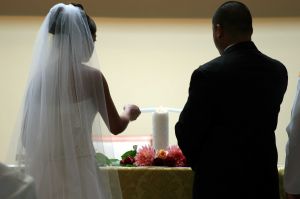 A wedding is a special celebration to join two individuals together. There are certain elements of the ceremony that have to be included, such as the declaration of intent and pronouncement, but everything else that happens is up to the couple. Practically every culture has its own traditions for a wedding. For example, Jews are usually married under the chuppah or wedding canopy. This structure is often built from trees that were planted at the birth ceremony of the bride and groom. Another Jewish tradition is that of breaking glass at the ceremony, which is symbolic of the fragility of marriage. In a Chinese wedding, the couple may have a tea ceremony during the service.
A wedding is a special celebration to join two individuals together. There are certain elements of the ceremony that have to be included, such as the declaration of intent and pronouncement, but everything else that happens is up to the couple. Practically every culture has its own traditions for a wedding. For example, Jews are usually married under the chuppah or wedding canopy. This structure is often built from trees that were planted at the birth ceremony of the bride and groom. Another Jewish tradition is that of breaking glass at the ceremony, which is symbolic of the fragility of marriage. In a Chinese wedding, the couple may have a tea ceremony during the service.
In our wedding guide here at the ULC, we offer scripts for five different traditions that are extremely symbolic to marriage. We'll explain each one here, to give you more information about choosing one for your ceremony.
Please note, the terms bride and groom are used simply for clarity.
- Candle-lighting: A unity candle is placed at the altar. Two pre-lit tapers should be available for the bride and groom to use to light the unity candle together. Each person holds a taper while the officiant says the words of the ceremony. When instructed, the two tapers are brought together to light the single candle. This symbolizes two spirits coming together as one. Just like the flame of the candle illuminates the dark, your union should illuminate your path together.
- Hand-fasting: A hand-fasting used to be a binding contract, but it is not legal any longer. Typically, it was a temporary marriage, almost like an engagement period. In our current ceremony, the officiant wraps a ribbon around the couple's interlocked hands. The binding of the hands symbolizes the binding of the two spirits. Although some cultures do have decrees that dictate the color and length of the cord, couples can adopt this custom to their own beliefs and traditions.
- Sand Ceremony: In this ritual, each couple receives a small vessel filled with sand. Preferably, each vessel should hold a different color. The officiant gives the command to pour the vessels into a larger vessel, representing marriage. The mixture of sand represents the lives of two coming together, forever entwined. The two different colors can never be truly separated, representing the two spirits that can never be torn apart.
- Jumping the Broom: Jumping the broom is an African tradition, symbolic of a wife willing to clean the courtyard of her new home. Some believe it was similar to a "leap of faith" but most historians do not agree. The practice survived Emancipation in America, even though it was not a tradition of slavery but of African culture. It fell out of practice for a while, but resurged after the publication of Alex Haley's "Roots." Jumping the broom is thought to be a transition to the new life of marriage.
- Tree-Planting: Before the ceremony, a sapling should be positioned in a pot or in the ground, ready to receive the soil. During the ceremony, the bride and groom are each given a vessel filled with soil. When the officiant gives the command, the soil is poured into the prepared vessel to plant the tree. As the tree becomes stronger each year, so should the marriage.
When you're planning your wedding, choose a special ceremony that celebrates your love and culture. You probably won't want to include more than two special traditions, but these types of rituals are ones that make unique memories that you'll have forever. You don't have to be African-American to include a jumping the broom ceremony, or Jewish to include a glass-breaking ceremony, but make sure you explain to your guests why it's important to you and your spouse.
Add Your Comment